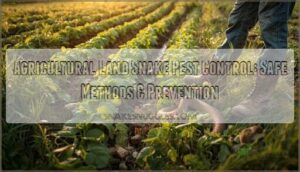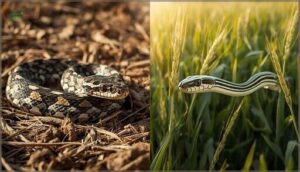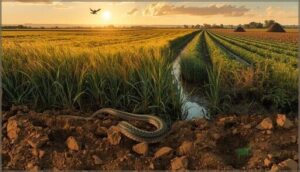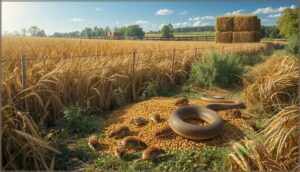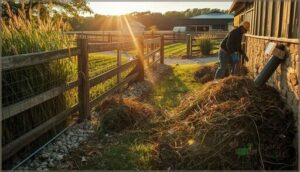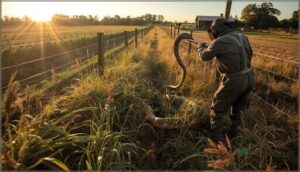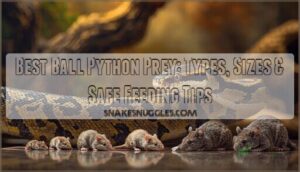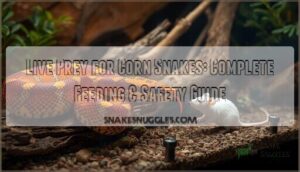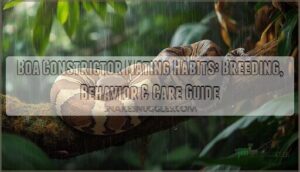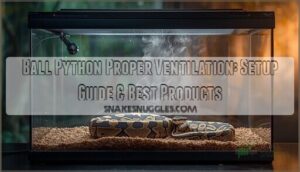This site is supported by our readers. We may earn a commission, at no cost to you, if you purchase through links.
A single snake slipping through a row of beans can send a ripple of concern across the whole field. You know the drill—one sighting, and suddenly everyone’s scanning the ground, boots crunching through stubble with a little more caution.
Snakes don’t just show up for the scenery; they follow the scent of rodents and the promise of shelter in brush piles or irrigation ditches.
Effective agricultural land snake pest control isn’t about waging war—it’s about understanding what draws snakes in, managing habitats wisely, and keeping your farm productive and safe. The right strategies put you back in control, not the snakes.
Table Of Contents
- Key Takeaways
- Common Snake Species on Agricultural Land
- Why Snakes Become Agricultural Pests
- Preventing Snake Problems on Farmland
- Safe and Effective Snake Removal Techniques
- Using Repellents and Deterrents Safely
- Promoting Sustainable Snake Management
- Frequently Asked Questions (FAQs)
- How to get rid of snakes in farms?
- Do pest control companies get rid of snakes?
- What is the best snake for pest control?
- How much does pest control charge to remove snakes?
- What are the common snake species in my region?
- How can I prevent snakes from entering my farmland?
- What are the safety precautions for handling venomous snakes?
- Are there any natural methods to deter snakes from my property?
- How can I educate my employees about snake identification and management?
- What snakes naturally control agricultural pests effectively?
- Conclusion
Key Takeaways
- You’ll prevent most snake problems by clearing tall grass, removing debris piles, sealing structural gaps smaller than a mouse, and installing mesh fencing buried 1–1.5 inches with posts every 8–10 feet.
- Snakes follow rodent populations into farmland, so controlling mice and rats through habitat management and proper storage directly reduces snake encounters while supporting natural pest control.
- Non-venomous species like rat snakes and kingsnakes consume over 70 percent rodents, potentially saving thousands in crop losses and reducing chemical pesticide needs when left undisturbed.
- Professional removal costs $150–$400 per visit and provides proper species identification, humane relocation, and liability protection that DIY methods can’t match, especially with venomous species.
Common Snake Species on Agricultural Land
You’ll encounter different snake species depending on your region, and knowing which ones live on your land makes a real difference. Some snakes pose risks to people and livestock, while others work as natural pest control that can save you money.
If you’re curious about how to spot venomous snakes or what to do after a bite, this guide to snake bites and safety tips offers practical advice tailored to your region.
Let’s look at how to identify the snakes you’re likely to see, understand their behavior, and decide which ones deserve a place on your farm.
For tips on spotting unique traits and rare color patterns, check out this guide to identifying rare ball python morphs in the field.
Identifying Venomous Vs. Non-venomous Snakes
Quick field checks can save lives. You’ll distinguish venomous from non-venomous species through hazard assessment features: triangular heads, vertical pupils, and distinct color banding in many venomous snakes.
For a deeper look at identifying dangerous snakes, check out this guide to venomous snake traits in Florida—it covers key features and safety tips.
For bite prevention and accurate venom detection, consider:
You’ll find practical tips for spotting warning signs and handling boas safely in this boa constrictor handling guide for snake enthusiasts.
- Head shape separated from neck versus smooth transitions
- Scale patterns along the belly for species classification
- Regional field guides confirming local venomous snake safety risks
Always maintain safe distance during snake identification.
Recognizing Local Snake Species
Once you’ve checked for venom detection markers, move to accurate species classification. Field guides with regional snake identification photos help you distinguish rattlesnakes from harmless rat snakes or garter snakes commonly found in crop margins.
Cross-reference scale patterns and body shapes against university extension resources for your area. This habitat analysis approach improves snake control decisions while reducing misidentification risks on your farmland.
Understanding Snake Behavior in Farmland
Once you’ve identified local species, pay attention to how snakes move through your fields. Their behavior reflects Farm Ecology and Rodent Control patterns. You’ll notice:
- Seasonal Snake Migration between crop edges and water sources
- Snake Denning in rock piles or debris near irrigation ditches
- Active hunting in field margins boosts Agricultural Productivity and fosters Agricultural Biodiversity, shaping effective Reptile Management.
Why Snakes Become Agricultural Pests
Snakes show up on farmland for a few key reasons that are easy to overlook. Understanding what draws them in can help you keep your land safer.
Let’s look at the main factors that turn snakes into pests around your fields and buildings.
Factors Attracting Snakes to Fields
Dense ground cover acts like a welcome mat for snakes, offering ideal Snake Habitat and hunting grounds. Field Ecology shifts when brush, stone piles, or moist microhabitats provide shelter.
These Snake Attractants—along with agricultural pests—draw both harmless and venomous snakes. Effective farm management practices and targeted snake control methods are essential for balancing agricultural productivity with safe rodent control.
Role of Rodents and Food Sources
Rodent Ecology shapes the heartbeat of farmland Food Web Dynamics. When mice and rats thrive in crop margins or storage areas, Snake Foraging ramps up, drawn by abundant prey populations.
If you’re curious about where snakes settle in these environments, explore the signs and secrets of a typical snake nest for a closer look at their role.
You’ll see this cycle boost agricultural biodiversity, but it’s a double-edged sword—snakes help with rodent control, yet high rodent numbers can attract unwanted snakes near your operation.
Typical Snake Habitats on Farms
Farm Edge Habitats and Irrigation Channels offer snakes both shelter and hunting grounds, especially where rodents thrive. You’ll often find these reptiles in Crop Alley Ecosystems, compost piles, or stored hay—warm, concealed spaces ideal for them.
Wetland Conservation near farmland also maintains snake habitats, reminding you that effective agricultural ecology and ecosystem management hinge on understanding these patterns.
Preventing Snake Problems on Farmland
Keeping snakes away from your farmland starts with a few practical steps. You’ll want to focus on what draws them in and how they’re getting around.
Here’s what you can do to make your property less inviting.
Managing Vegetation and Debris
Ever notice how snakes vanish when you clear tall grass? Vegetation Control and Debris Removal are your first line of defense. Field Maintenance and Habitat Modification reduce hiding spots and food sources, keeping snakes at bay and supporting Ecosystem Balance.
- Mow grass to a uniform height
- Remove brush piles
- Clear crop stubble post-harvest
- Eliminate discarded plastics
- Maintain tidy field edges
Sealing Entry Points in Structures
Think a mouse-sized crack is too small for trouble? Snakes slip through gaps in doors, crawl space vents, and foundation joints with ease.
Weatherproofing with door sweeps, installing vent screens, and sealing utility penetrations are essential for effective Snake Proofing.
Regular inspections and maintenance form your frontline in Snake Prevention, supporting Pest Control and Wildlife Removal Techniques across your operation.
Installing Snake-Proof Fencing and Barriers
A single gap in your perimeter can be an open door for snakes. Prioritize Snake Proof Fence installation using corrosion-resistant Barrier Materials and smart Fence Design.
For sturdy Perimeter Security and effective Snake Proofing, focus on:
- Mesh no larger than 6 inches
- Skirt buried 1–1.5 inches
- Posts every 8–10 feet
- UV-stable coatings
- Annual Maintenance Schedules
Safe and Effective Snake Removal Techniques
When snakes turn up on your land, you need a plan that keeps everyone safe. There are a few practical ways to handle removal without putting yourself at risk.
Here’s what you should know before choosing your next step.
Humane Trapping and Relocation
Relocating snakes isn’t just about moving a problem—it’s about doing right by the animal and your land. You’ll need well-designed snake traps, clear wildlife permits, and a release strategy that respects relocation ethics.
Check traps often and handle snakes calmly to prevent injury. Place snakes in suitable habitats, always beyond their typical home range.
| Trap Design | Release Strategies |
|---|---|
| Noninjurious, labeled | Beyond home range |
| Frequent checks | Suitable habitat |
| Wildlife permits | Post-relocation monitoring |
DIY Vs. Professional Snake Removal
When you weigh DIY snake removal against hiring professionals, consider more than just Removal Costs. Safety Protocols and Handling Techniques matter—insurance often won’t cover bites or property damage. Licensed Wildlife Control uses proper Equipment Choices and follows strict Snake Control Methods. If you value peace of mind, remember:
- Liability Concerns
- Accurate species ID
- Humane Pest Control Strategies
- Reliable Snake Removal outcomes
Avoiding Risks During Snake Encounters
After weighing DIY against professional removal, your next step is mastering Snake Safety Tips and Encounter Protocols. Keep a safe distance—six to ten feet is wise—and never corner a snake.
Use boots, gloves, and long pants for Personal Protection. If bitten, prioritize Emergency Response by calling for help immediately.
Quick Risk Assessment and calm actions are your best Snake Bite Prevention methods.
Using Repellents and Deterrents Safely
Keeping snakes away from your fields calls for more than guesswork. You need safe, proven methods that actually work.
Here’s what you should know about using repellents and deterrents on your land.
Evaluating Chemical Repellent Effectiveness
You’ll often find that repellent efficacy varies widely with chemical formulations and field conditions. For instance, sodium nitrite and ammonia-based snake repellents can reduce encounters by 10–70%, though weather and prey presence affect results.
Always weigh agricultural safety and repellent toxicity before use, and consult pest control product reviews to select snake control products that target venomous snakes without harming non-target species.
Non-chemical Deterrent Options
If chemical snake repellents leave you questioning safety, Habitat Modification and Physical Barriers offer reliable alternatives. Snake-proof fencing blocks up to 90% of ingress when maintained, while Targeted Zoning and debris removal make fields less attractive.
Visual Deterrents, like reflective tape, and Acoustic Devices add extra layers for Outdoor Pest Management, strengthening your Wildlife Management and Conservation strategy.
Application Guidelines and Safety Precautions
Before applying any Snake Control Products, prioritize Personal Protection—thick gloves, eye protection, and proper Equipment Maintenance are essential for Safe Handling. Always follow label directions for Chemical Use, keeping repellents away from water sources and crops.
For Outdoor Pest Management, post Emergency Response contacts and restrict access to treated areas. Document all Pest Control and Removal steps, especially with Venomous Snakes.
Promoting Sustainable Snake Management
Sustainable snake management means looking at the bigger picture on your land. You want to protect your crops while keeping the ecosystem balanced.
Here are some practical options to help you do both.
Benefits of Natural Snake Populations
Consider this: a single snake can save you thousands in lost crops by controlling rodents. Their natural role in Pest Control strengthens Ecosystem Balance and Biodiversity Support, reducing chemical use and boosting Agricultural Productivity and Sustainability.
A single snake can save thousands in crop losses by naturally controlling rodents and reducing the need for chemical pest control
Embracing Benefits of Snakes on Farms aligns with Wildlife and Ecosystem Management, supporting Reptile Management and ongoing Conservation Efforts for long-term farm health.
Balancing Pest Control With Conservation
Balancing pest control with Conservation Efforts means integrating Sustainable Practices that support Wildlife Preservation and Ecosystem Balance. You can use Integrated Management—habitat modification, exclusion, and non-lethal Reptile and Rodent Control—to reduce conflicts.
These steps strengthen Biodiversity Conservation and Environmental Sustainability, letting Snake Conservation and Management work alongside effective Wildlife and Ecosystem Management for long-term farm resilience.
Collaborating With Wildlife Agencies
Why go it alone when partnership models with wildlife agencies can transform your snake management strategy? Agency outreach gives you access to wildlife training, regulatory compliance support, and up-to-date conservation goals. Tap into environmental services and the National Wildlife Species Information Center for practical guidance.
- Formal partnership agreements
- Farm-specific snake activity data sharing
- Wildlife agency consultations
- Permit support for snake control and removal
Frequently Asked Questions (FAQs)
How to get rid of snakes in farms?
Picture a field where tall grasses meet scattered debris—prime real estate for snakes.
Start with Farm Snake Inspections, modify habitat, seal entry points, and use Agricultural Snake Deterrents.
Rural Snake Management relies on targeted Snake Proofing Methods and safe removal.
Do pest control companies get rid of snakes?
Yes, pest control services commonly offer professional removal of snakes, relying on wildlife experts trained in safe snake handling. Snake removal costs vary, but licensed technicians manage pest removal, reptile control, and prevention, often coordinating with animal control for safety.
What is the best snake for pest control?
Imagine corn snakes weaving through tall grass, quietly handling rodent control.
Non-venomous rat snakes and kingsnakes are top choices for pest management, supporting eco balance without risking pesticide safety—key for effective farm management and reptile management best practices.
How much does pest control charge to remove snakes?
Removal Costs for snakes generally range from $150 to $400 per visit, with Service Fees rising for venomous species, Emergency Charges, or complex jobs.
Pricing Models vary regionally, so always confirm local rates before scheduling Animal Removal or Pest Management Strategies.
What are the common snake species in my region?
Regional Snake Types vary, but most farms see garter snakes, rat snakes, and water snakes. Venomous snakes like rattlesnakes or copperheads may appear, so use Local Species Lists for accurate Snake Identification and effective Agricultural Snake Control.
How can I prevent snakes from entering my farmland?
Think of your perimeter as a filter—keep it tight. Habitat modification clears cover, entry point sealing blocks gaps, and snake-proof fencing with barrier installation stops movement.
Farm sanitation and snake repellents reinforce your defense against venomous snakes.
What are the safety precautions for handling venomous snakes?
Wear cut-resistant gloves and sturdy boots when approaching venomous snakes. Use long-handled tools to maintain distance.
Keep emergency response plans ready, and don’t attempt toxic snake handling alone—contact trained professionals immediately.
Are there any natural methods to deter snakes from my property?
Some folks swear snakes hate vibrations and ultrasonic devices—results vary wildly.
You’ll find better success with habitat modification: trim vegetation, remove debris, seal gaps, and install natural barriers around your property for outdoor safety.
How can I educate my employees about snake identification and management?
Train your team to identify venomous snakes using head shape and scale patterns. Provide regional species photo guides, emphasize safety protocols, and schedule annual refreshers to keep staff training current on wildlife awareness and farm risk management.
What snakes naturally control agricultural pests effectively?
Before you stock your farm with carrier pigeons, consider rat snakes—they consume over 70 percent rodents. Gophersnakes tackle gophers and voles, while timber rattlesnakes specialize in pest rodent control through ambush foraging strategies.
Effective pest control methods can markedly reduce the need for chemical pesticides.
Conclusion
One snake can disrupt an entire season’s peace of mind, but it doesn’t have to. Agricultural land snake pest control starts with smart prevention—clearing debris, managing rodent populations, and creating barriers that keep unwanted visitors at bay.
When you combine habitat management with humane removal practices, you’re not just solving a problem; you’re building a safer, more productive farm. Take control of your land, respect the balance, and reclaim the confidence that comes with knowing your fields are secure.

